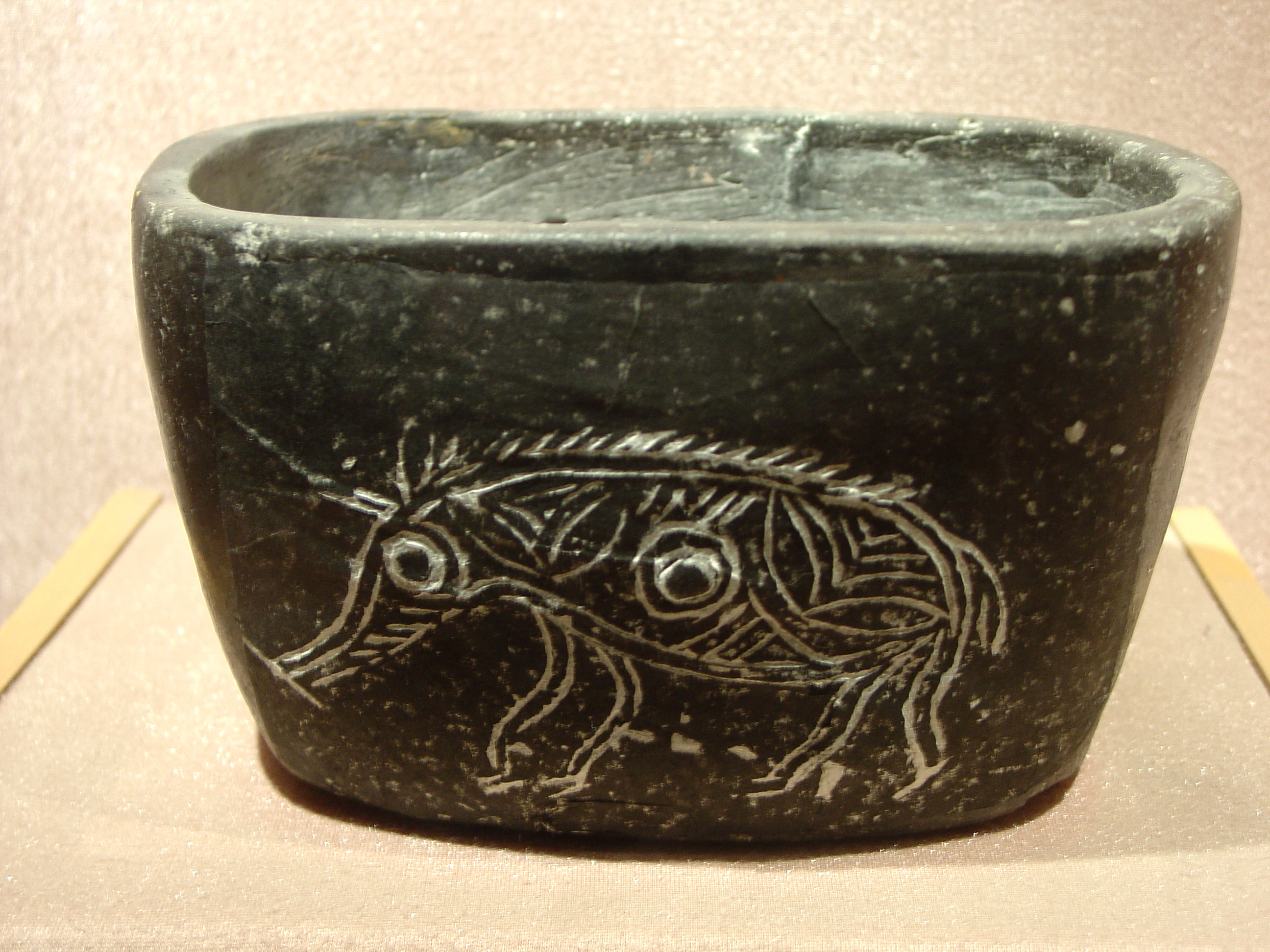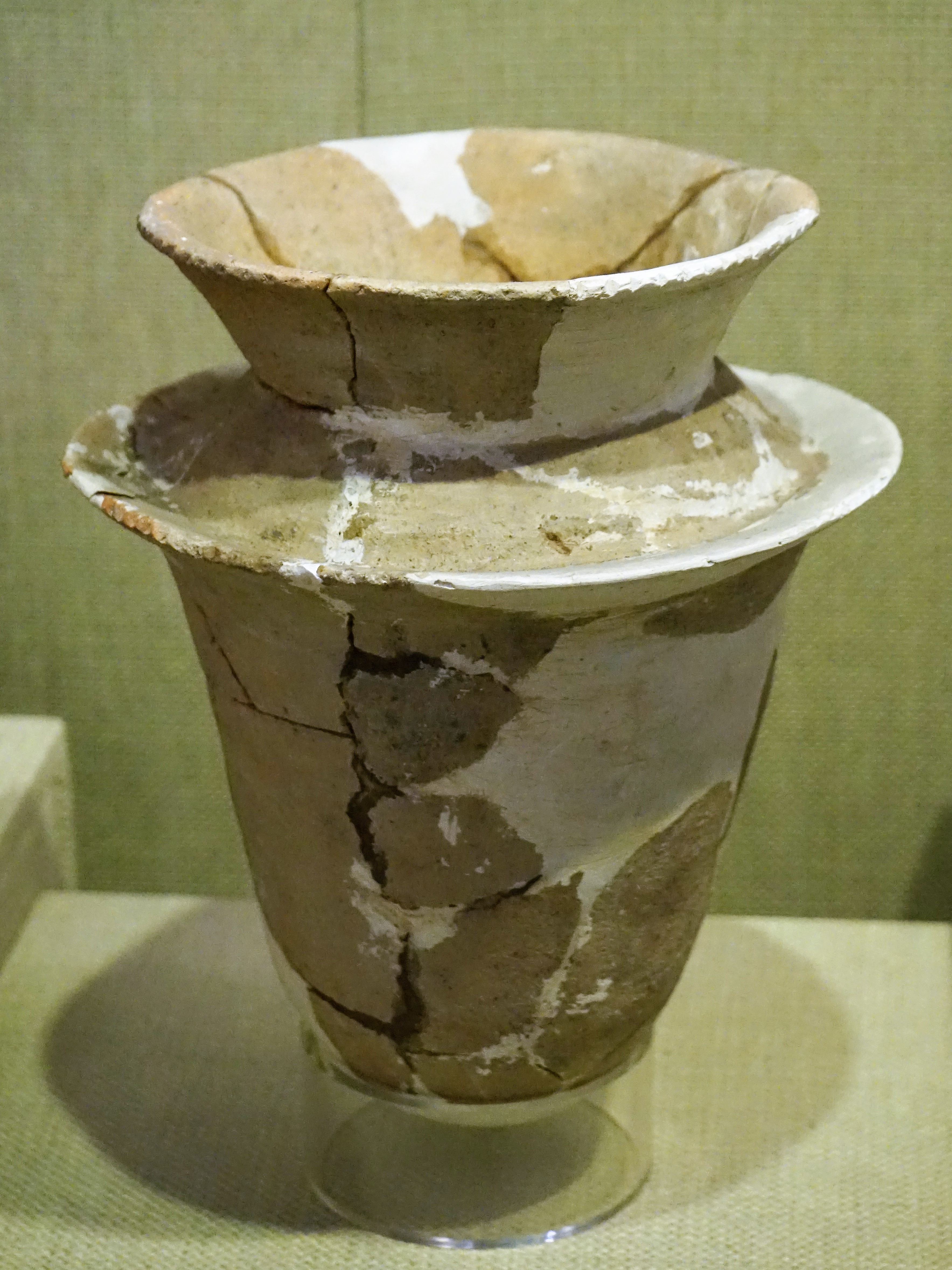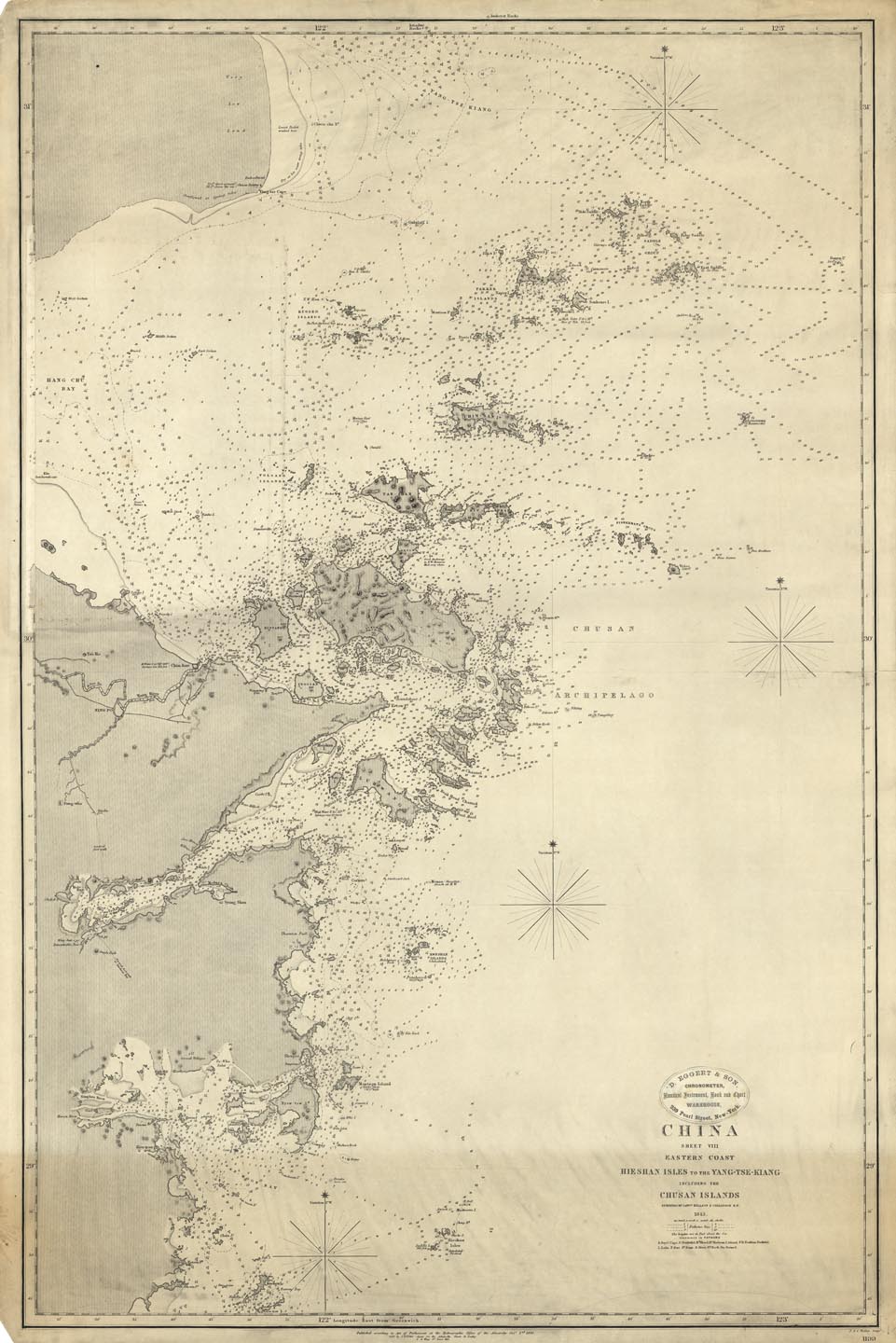|
Hemudu
The Hemudu culture (5500 BC to 3300 BC) was a Neolithic culture that flourished just south of the Hangzhou Bay in Jiangnan in modern Yuyao, Zhejiang, China. The culture may be divided into early and late phases, before and after 4000 BC respectively. The site at Hemudu, 22 km northwest of Ningbo, was discovered in 1973. Hemudu sites were also discovered at Tianluoshan in Yuyao city, and on the islands of Zhoushan. Hemudu are said to have differed physically from inhabitants of the Yellow River sites to the north. Some authors propose that the Hemudu Culture was a source of the pre-Austronesian cultures. Material culture Some scholars assert that the Hemudu culture co-existed with the Majiabang culture as two separate and distinct cultures, with cultural transmissions between the two. Other scholars group Hemudu in with Majiabang subtraditions. Two major floods caused the nearby Yaojiang River to change its course and inundated the soil with salt, forcing the people of Hem ... [...More Info...] [...Related Items...] OR: [Wikipedia] [Google] [Baidu] |
Ningbo
Ningbo (; Ningbonese: ''gnin² poq⁷'' , Standard Mandarin pronunciation: ), formerly romanized as Ningpo, is a major sub-provincial city in northeast Zhejiang province, People's Republic of China. It comprises 6 urban districts, 2 satellite county-level cities, and 2 rural counties, including several islands in Hangzhou Bay and the East China Sea. Ningbo is the southern economic center of the Yangtze Delta megalopolis, and is also the core city and center of the Ningbo Metropolitan Area. To the north, Hangzhou Bay separates Ningbo from Shanghai; to the east lies Zhoushan in the East China Sea; on the west and south, Ningbo borders Shaoxing and Taizhou respectively. As of the 2020 Chinese National Census, the entire administrated area of Ningbo City had a population of 9.4 million (9,404,283), of which 4,479,635 lived in the built-up (or metro) area of its five urban districts. Within the next decade, the cities of Cixi, Yunhao and Fenghua will likely also be co ... [...More Info...] [...Related Items...] OR: [Wikipedia] [Google] [Baidu] |
Majiabang Culture
The Majiabang culture, also named Ma-chia-pang culture, was a Chinese Neolithic culture that existed at the mouth of the Yangtze River, primarily around Lake Tai near Shanghai and north of Hangzhou Bay. The culture spread throughout southern Jiangsu and northern Zhejiang from around 5000 BC to 3300 BC. The later part of the period is now considered a separate cultural phase, referred to as the Songze culture. After that, It was followed by the Liangzhu culture, and co-existed with the Hemudu culture. Based on the discoveries of the archaeological findings, archaeologists had raised the statement that Majiabang culture is the origin of the early fishing, hunting and gathering economy in China, and its agriculture was developed, especially for the farming of rice, people living in this period used this as an economic method of production. Majiabang people cultivated rice. At Caoxieshan and Chuodun, sites of the Majiabang culture, archaeologists excavated paddy fields, indicating th ... [...More Info...] [...Related Items...] OR: [Wikipedia] [Google] [Baidu] |
Majiabang
The Majiabang culture, also named Ma-chia-pang culture, was a Chinese Neolithic culture that existed at the mouth of the Yangtze River, primarily around Lake Tai near Shanghai and north of Hangzhou Bay. The culture spread throughout southern Jiangsu and northern Zhejiang from around 5000 BC to 3300 BC. The later part of the period is now considered a separate cultural phase, referred to as the Songze culture. After that, It was followed by the Liangzhu culture, and co-existed with the Hemudu culture. Based on the discoveries of the archaeological findings, archaeologists had raised the statement that Majiabang culture is the origin of the early fishing, hunting and gathering economy in China, and its agriculture was developed, especially for the farming of rice, people living in this period used this as an economic method of production. Majiabang people cultivated rice. At Caoxieshan and Chuodun, sites of the Majiabang culture, archaeologists excavated paddy fields, indicating th ... [...More Info...] [...Related Items...] OR: [Wikipedia] [Google] [Baidu] |
Yuyao
Yuyao () is a county-level city in the northeast of Zhejiang province, China. It is under the jurisdiction of the sub-provincial city of Ningbo. It is located west of central Ningbo, east of Hangzhou, bordering Hangzhou Bay in the north. Yuyao covers an area of . Demographics As of the 2020 census, its population was 1,254,032. Its built-up (or metro) area with the county-level city of Cixi largely conurbated, had 3,083,520 inhabitants. However, recently the migrated workers and their families have increase the total population to about 1.6 million, but they do not show up in the official census and other related statistics data. Geography and climate Yuyao lies in a subtropical monsoon zone, rich in sunshine and rain fall, warm and humid, distinct in the four seasons. The mean annual sunshine is 2,061 hours and the annual rate of sunshine is 47%. The mean annual temperature is 16 degree Celsius and the coldest months perennially are January and February, the hottest are July ... [...More Info...] [...Related Items...] OR: [Wikipedia] [Google] [Baidu] |
Neolithic China
This is a list of Neolithic cultures of China that have been unearthed by archaeologists. They are sorted in chronological order from earliest to latest and are followed by a schematic visualization of these cultures. It would seem that the definition of Neolithic in China is undergoing changes. The discovery in 2012 of pottery about 20,000 years BC indicates that this measure alone can no longer be used to define the period. It will fall to the more difficult task of determining when cereal domestication started. List Schematic outline These cultures are existed for the period from 8500 to 1500 BC. Neolithic cultures remain unmarked and Bronze Age cultures (from 2000 BC) are marked with *. There are many differences in opinion by dating these cultures, so the dates chosen here are tentative: For this schematic outline of its neolithic cultures China has been divided into the following nine parts: #Northeast China: Inner Mongolia, Heilongjiang, Jilin and Liaoning. #Northwes ... [...More Info...] [...Related Items...] OR: [Wikipedia] [Google] [Baidu] |
Hangzhou 2006 18-64
Hangzhou ( or , ; , , Standard Mandarin pronunciation: ), also romanized as Hangchow, is the capital and most populous city of Zhejiang, China. It is located in the northwestern part of the province, sitting at the head of Hangzhou Bay, which separates Shanghai and Ningbo. Hangzhou grew to prominence as the southern terminus of the Grand Canal and has been one of China's most renowned and prosperous cities for much of the last millennium. It is a major economic and e-commerce hub within China, and the second biggest city in Yangtze Delta after Shanghai. Hangzhou is classified as a sub-provincial city and forms the core of the Hangzhou metropolitan area, the fourth-largest in China after Guangzhou-Shenzhen Pearl River agglomeration, Shanghai-Suzhou-Wuxi-Changzhou conurbation and Beijing. As of 2019, the Hangzhou metropolitan area was estimated to produce a gross metropolitan product (nominal) of 3.2 trillion yuan ($486.53 billion), making it larger than the economy of Nigeria ... [...More Info...] [...Related Items...] OR: [Wikipedia] [Google] [Baidu] |
Neolithic
The Neolithic period, or New Stone Age, is an Old World archaeological period and the final division of the Stone Age. It saw the Neolithic Revolution, a wide-ranging set of developments that appear to have arisen independently in several parts of the world. This "Neolithic package" included the introduction of farming, domestication of animals, and change from a hunter-gatherer lifestyle to one of settlement. It began about 12,000 years ago when farming appeared in the Epipalaeolithic Near East, and later in other parts of the world. The Neolithic lasted in the Near East until the transitional period of the Chalcolithic (Copper Age) from about 6,500 years ago (4500 BC), marked by the development of metallurgy, leading up to the Bronze Age and Iron Age. In other places the Neolithic followed the Mesolithic (Middle Stone Age) and then lasted until later. In Ancient Egypt, the Neolithic lasted until the Protodynastic period, 3150 BC.Karin Sowada and Peter Grave. Egypt in th ... [...More Info...] [...Related Items...] OR: [Wikipedia] [Google] [Baidu] |
Zhejiang
Zhejiang ( or , ; , also romanized as Chekiang) is an eastern, coastal province of the People's Republic of China. Its capital and largest city is Hangzhou, and other notable cities include Ningbo and Wenzhou. Zhejiang is bordered by Jiangsu and Shanghai to the north, Anhui to the northwest, Jiangxi to the west and Fujian to the south. To the east is the East China Sea, beyond which lies the Ryukyu Islands. The population of Zhejiang stands at 64.6 million, the 8th highest among China. It has been called 'the backbone of China' due to being a major driving force in the Chinese economy and being the birthplace of several notable persons, including the Chinese Nationalist leader Chiang Kai-shek and entrepreneur Jack Ma. Zhejiang consists of 90 counties (incl. county-level cities and districts). The area of Zhejiang was controlled by the Kingdom of Yue during the Spring and Autumn period. The Qin Empire later annexed it in 222 BC. Under the late Ming dynasty and the Qing ... [...More Info...] [...Related Items...] OR: [Wikipedia] [Google] [Baidu] |
Pre-Austronesian
The Austronesian peoples, sometimes referred to as Austronesian-speaking peoples, are a large group of peoples in Taiwan, Maritime Southeast Asia, Micronesia, coastal New Guinea, Island Melanesia, Polynesia, and Madagascar that speak Austronesian languages. They also include indigenous ethnic minorities in Vietnam, Cambodia, Myanmar, Thailand, Hainan, the Comoros, and the Torres Strait Islands. The nations and territories predominantly populated by Austronesian-speaking peoples are sometimes known collectively as Austronesia. Based on the current scientific consensus, they originated from a prehistoric seaborne migration, known as the Austronesian expansion, from pre- Han Taiwan, at around 1500 to 1000 BCE. Austronesians reached the northernmost Philippines, specifically the Batanes Islands, by around 2200 BCE. Austronesians used sails some time before 2000 BCE. In conjunction with their use of other maritime technologies (notably catamarans, outrigger boats, lashed-lug bo ... [...More Info...] [...Related Items...] OR: [Wikipedia] [Google] [Baidu] |
Zhoushan
Zhoushan , formerly romanized as Chusan, is an urbanized archipelago with the administrative status of a prefecture-level city in the eastern Chinese province of Zhejiang. It consists of an archipelago of islands at the southern mouth of Hangzhou Bay, off Ningbo. The prefecture's city proper is Dinghai on Zhoushan Island, now administered as the prefecture's Dinghai District. During the 2020 census, Zhoushan Prefecture's population was 1,157,817, out of whom 882,932 lived in the built-up (or metro) area made of two urban districts of Dinghai and Putuo. On 8 July 2011 the central government approved Zhoushan as Zhoushan Archipelago New Area, a state-level new area. History The archipelago was inhabited 6,000 years ago during the Neolithic by people of the Hemudu culture. During the Spring and Autumn period, Zhoushan was called Yongdong, referring to its location east of the Yong River. At the time, it belonged to the state of Yue. The fishermen and sailors who inhab ... [...More Info...] [...Related Items...] OR: [Wikipedia] [Google] [Baidu] |
Gorgon Euryale
''Euryale ferox,'' commonly known as prickly waterlily, makhana or Gorgon plant, is a species of water lily found in southern and eastern Asia, and the only extant member of the genus ''Euryale''. The edible seeds, called fox nuts or ''makhana'' when dried, are eaten in Asia. Though normally classified in the water lily family, Nymphaeaceae, the species is occasionally regarded as a distinct family, Euryalaceae. Unlike other water lilies, the pollen grains of ''Euryale'' have three nuclei. Etymology The genus is named after a mythical Greek Gorgon, Euryale. Growth ''Euryale'' ''ferox'' is a perennial plant native to eastern Asia and southern Asia, and is found from northeast India to Korea and Japan, as well as parts of eastern Russia. The Indian state of Bihar produces 90% of the world's fox nuts. It grows in water, producing bright purple flowers. The leaves are large and round, often more than a meter (3 feet) across, with a leaf stalk attached in the centre of t ... [...More Info...] [...Related Items...] OR: [Wikipedia] [Google] [Baidu] |
Lacquer
Lacquer is a type of hard and usually shiny coating or finish applied to materials such as wood or metal. It is most often made from resin extracted from trees and waxes and has been in use since antiquity. Asian lacquerware, which may be called "true lacquer", are objects coated with the treated, dyed and dried sap of ''Toxicodendron vernicifluum'' or related trees, applied in several coats to a base that is usually wood. This dries to a very hard and smooth surface layer which is durable, waterproof, and attractive in feel and look. Asian lacquer is sometimes painted with pictures, inlaid with shell and other materials, or carved, as well as dusted with gold and given other further decorative treatments. In modern techniques, lacquer means a range of clear or pigmented coatings that dry by solvent evaporation to produce a hard, durable finish. The finish can be of any sheen level from ultra matte to high gloss, and it can be further polished as required. Lacquer finishes ... [...More Info...] [...Related Items...] OR: [Wikipedia] [Google] [Baidu] |




%2C_King_of_Wuyue.jpg)


